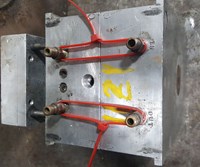 Through ongoing data integration and training, the AI-based software evolves into a customized manufacturing co-pilot. It delivers precise recommendations for production planning and CAM programming. Source (all images): up2parts
Through ongoing data integration and training, the AI-based software evolves into a customized manufacturing co-pilot. It delivers precise recommendations for production planning and CAM programming. Source (all images): up2partsAs mold shops face increasing demands to deliver complex tooling faster — often with fewer experienced hands — many are turning to artificial intelligence (AI) to streamline operations. While AI is not a replacement for skilled workers, it can be a helpful tool to improve precision, save time and preserve valuable expertise.
Here are five ways AI-enabled software can support moldmaking today:
1. Add Structure to Unstructured Data
Moldmaking generates a wide range of data — handwritten tolerances, tribal knowledge, legacy part files — often lacking organization. AI-powered platforms can bring structure to this information, making it easier to find, interpret and apply. By identifying and labeling features, tolerances and material specifications, these systems lay the groundwork for better quoting and programming decisions.
2. Streamline Quoting with Feature Recognition
Modern quoting tools can analyze CAD models, recognize features and cross-reference them with historical job data. This allows the software to estimate process steps, machining times and material usage more quickly and accurately. What used to take days can now take minutes, freeing up time for more strategic work.
3. Use CAM Integration to Improve Programming
AI-generated part data can be passed directly into CAM software, helping programmers build toolpaths using actual tolerance and feature information — not just geometry. This reduces guesswork and ensures that programs are based on real manufacturing requirements, improving accuracy and reducing the chance of rework.
4. Customize AI to Fit Your Shop
Rather than using one-size-fits-all automation, some AI tools allow shops to

With AI-enabled software, moldmakers can build a future-proof process chain based on 3D models for more transparency and availability of production-relevant component information.
train the system using their own workflows, tooling strategies and job history. This shop-specific learning means the software improves over time, getting better at reflecting how your team works — and helping new users get up to speed faster.
5. Support Workforce Development
With experienced moldmakers retiring, capturing their decision-making process is more important than ever. AI platforms can act as digital mentors by embedding past practices into daily operations. This helps less experienced employees learn the "why" behind certain decisions and builds a foundation for long-term skills development.
AI in moldmaking is still evolving, but today’s tools already offer practical benefits. By organizing data, improving quoting and CAM efficiency, and supporting workforce continuity, AI can help mold shops work smarter — not just faster.
Related Content
-
How to Use Scientific Maintenance for More Accurate Mold and Part Troubleshooting
Discover how adopting scientific maintenance approaches helps improve mold lifespan, minimize failures, and optimize production outcomes.
-
Three Good Reasons to Switch from Three- to Five-Axis Machining in Moldmaking
Five-axis machining technology is a great tool in the moldmaker toolbox.
-
It Starts With the Part: A Plastic Part Checklist Ensures Good Mold Design
All successful mold build projects start with examining the part to be molded to ensure it is moldable and will meet the customers' production objectives.
















